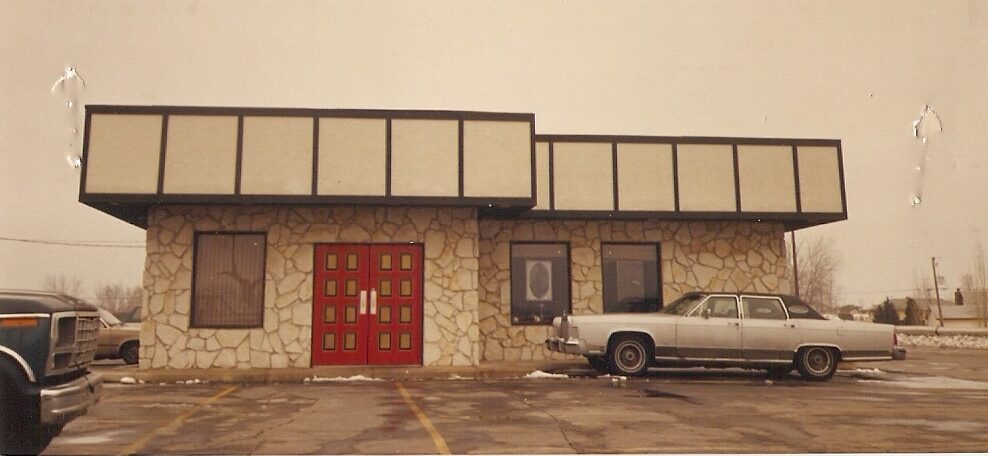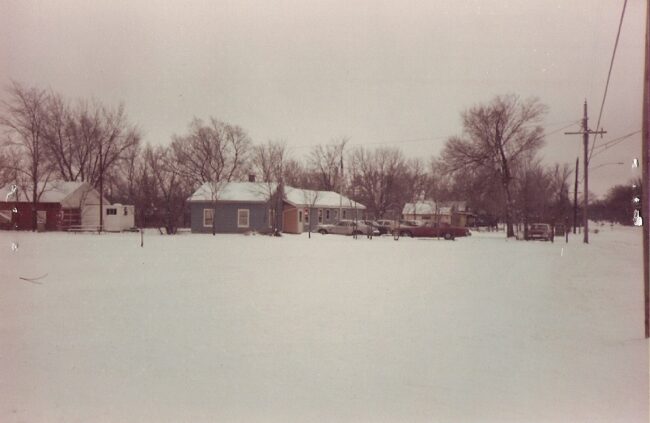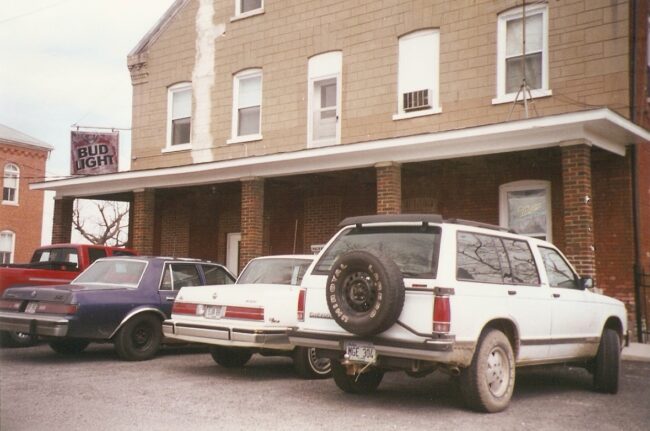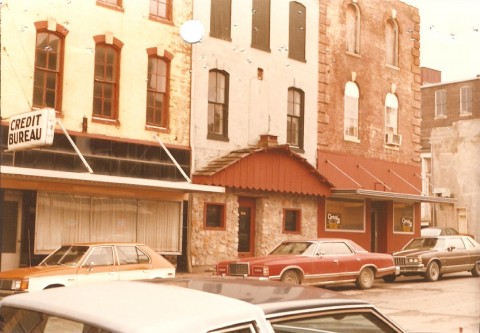
It’s time, once again, to return to those once upon a time daily drivers of the past, in 1980s and 1990s Illinois. How about a nice opera-windowed Continental? This was taken in Plainfield, IL on February 26, 1986.
 Roscoe IL, 12/11/85
Roscoe IL, 12/11/85
This photo was taken from a distance, but if you look hard you can see a Nova, Fairmont Futura, 1975-76 LeSabre sedan, and another Fairmont. See any SUVs? No? Me either. People drove cars back then, even in, *GASP* winter. Trucks were for good ol’ boys or tradesmen. By the way, Roscoe is a small town just a bit north of Rockford.
 St. Liberty IL, 1/26/96
St. Liberty IL, 1/26/96
Okay, there is an SUV in this photo, but it’s a nice compact S10 Blazer. These rusted really fast in my neck of the woods, and few have survived to the present day. I’ll take the ’85-’90 Park Avenue, thanks.
 Urbana IL, 12/30/85
Urbana IL, 12/30/85
There’s a nice Subaru GL, Corolla wagon and ’73 Sedan de Ville in this photo, but that classic diner steals this scene from 1985. I wonder if it’s still there…
 Quincy IL, 3/12/86
Quincy IL, 3/12/86
Let’s close out this week’s trip into the past with this shot from Quincy, with a ’70s-tastic two-tone white and burnt orange Omni, bright red LTD Landau and my favorite B-body, a ’79 Bonneville. Remember these images when you’re sharing the road with all the Silver Silvermist and January Bleak Pearl Equinoxes, Rogues and ‘Rollas, they’ll help get you through.







26 Comments
Thanks again Tom for the interesting pictures and commentary. The 80s and early 90s were a time of transition as many full-size folks held on to their 1970s era land yachts, but CAFE and the 79-80 fuel crisis led car makers and many consumers to shift to penalty box small cars or the lethargic and strangely proportioned downsized larger cars which were not nearly as satisfying in most cases. It therefore isn’t too surprising that after 15-20 years of nursing an old land yacht along or cramped up in some FWD penalty box that many buyers decided to switch from cars to pickups and SUVs where you could still get a V-8 and the “safety” of two+ tons of steel, 4WD, and a commanding driving position.
Drivers used snow tires back then, at least on the back and often studded. You had to.
Go to a ski resort today and you’ll see a slim majority of combovers with no-seasons, followed by a strong second of big utes and pickups and then the occasional wagon or hot hatch with snows…all driven way too fast because of the electronic nannies.
I lived in the snow belt my whole life, and I remember the fall season switch to rear snow tires as an annual ritual during the bias-ply days, but as radials became popular they became known for being adequate in light snow and hence most people just drove on summer radials during the winter. In 1974-5 GM introduced the first “all-season” radial tread pattern that took off and was widely copied, which pretty much finished off the snow tire market for all but the hard core. FWD became popular in the late 70s and early 80s and was widely touted as vastly superior in snow, which further reduced the perceived need for snow tires. Winter tires started to make a come-back only when more cars started to come with wide low-profile performance rubber that were worthless in snow and ice, but by then many people were switching to 4 wheel drive in the snow belt in part so they wouldn’t need snow tires. Of course it didn’t take too long before SUV/CUV and even pickups started to come with wide low-profile performance rubber and the snow tire market picked up again.
Interesting that last shot in front of the credit bureau with the two toned Omni. At the time it was built, The American version of the Omni was clearly having a big impact on the kind of customization VW would offer on the Rabbits coming out of Westmoreland. You couldn’t get a Simca or Talbot or Valmet Horizon or a Euro Golf that looked like that. VW even bumped up the engine to the previously only sold to Chrysler 1.7 gas engine.
By the time this photo was taken in 1986, that had all stopped. The Omni looked much more like the Simca and even the VW engine had been chucked in favor of the old Simca engine. Grill and chrome was all blacked out and the color choices leaned toward the modern greyscale. Meanwhile Westmoreland was about to close with all the tooling moving to the never ending purgatory of South Africa and China. Not sure why customizing for the USA market failed so.
There was a short period during the late 70s and early 80s when people were viewing an Omni or Rabbit as a substitute for a much larger car because we were supposedly running out of oil and gas prices would continue to rocket upward as they had during the 70s gas crises, and as a substitute they were more likely to load them up with the 2 tone paint, A/C, velour seats, power everything in the same way they would have normally loaded up a Caprice or LTD. As the 80s progressed and gas prices dropped and Reagan optimism prevailed, which led many car buyers to start moving back towards the larger vehicles they preferred and small cars (especially American brands) reverted to their previous status as cheap 2nd/3rd cars for the kids, commuter specials, etc. and were more rarely ordered with fancy options unless they had sporting pretensions. US and Japanese manufacturers were happy to oblige because barebones small cars meant more customers could be easily persuaded to buy bigger more profitable models.
I think your right Stingray. Makes you wonder if Accords had stayed at their 82-85 size, would Marysville assembly gone the way of Westmoreland?
The interplay between Rabbit and Omni, both here and overseas, is fascinating in retrospect. I think Stingray’s note on the change in Omni buyer demographics is pretty fair, but there are a few Omni-specific things to note. The first is the availability of the 2.2 which really made the Omni a delight to drive. The second is the “America” and “Miser” sub-models which really showed Iacocca’s ability to target and serve a particular demographic; the Miser fuel economy was a BIG DEAL back in the day, while the availability of a low-cost 2.2 was pretty neat. The Omni was pretty much always a slightly better car than the equivalent Rabbit in terms of comfort, equipment, and power, but it wasn’t built very well, even compared to the Westmoreland Rabbit.
All of that being said, it should also be noted that the existence of the Reliant and Aries had some downward pressure on Omni and Horizon spec from 1981 forward. No sense buying a loaded Horizon when a loaded Reliant barely cost any more.
Jack, where do you come out on the origin of the Chrysler 2.2? Nedermeyer, the elder, made the case that the engine is an upsize copy of the VW engine that Chrysler had bought for the Omni. At allpar, a while back they interviewed the engineer in charge of the 2.2 and the slant six before it and emphasized the natural progression between the two economy engines.
That’s precisely what I would expect PN to say.
Everything I can find suggests that the similarities were either established practice beyond VW (aluminum head on an iron block) or designed to make the 2.2 an easier fit into existing 1.7-equipped cars (location of exhaust, accessory drives).
The Simca “Poissy” engine had an alloy head in the Sixties.
The 2.2 was engineered in-house by Chrysler and was not a copy of anything. This is an even dumber version of the “OMG LX IS JUST A W210” bull-puckey where people start off by claiming that the Chrysler 300C was a badge-engineered Benz and wind up relying on statements like, “uh, some of the rear suspension pickup locations are similar”.
This is an even dumber version of the “OMG LX IS JUST A W210” bull-puckey where people start off by claiming that the Chrysler 300C was a badge-engineered Benz and wind up relying on statements like, “uh, some of the rear suspension pickup locations are similar”.
Thank you. I’ve taken apart every nut and bolt on the various LX cars and while the underpinnings, particularly of the older cars look similar, they aren’t the same. The early cars did have a few random parts with the three pointed star on them (steering column, transmission… trying to think of others).
The late model cars look similar to the early cars, they are substantially different where it counts as well. The neat thing is that the majority of the important stuff bolts in the same places across all years, so we’re seeing a lot of interesting mashups.
Hellcat Charger wagon? Sure! The running gear and subframes bolt in.
These cars are a paradise for the new generation of hot rodders.
Good point Jack, I’m sure Carmine or Tom can remember or look it up, but I’m pretty sure the Miser versions were not available with A/C or most other types of weight increasing/power sapping options as a way to get the advertised EPA MPG rating super high to lure people in the showroom where most would be talked into a more profitable and comfortable K-car variant. Furthermore, a loaded Omni/Horizon not only cost almost as much, but probably only got 1 or 2 mpg more than a loaded Aries/Reliant, so why not get the extra stretch out space?
The Misers were just that….miserly, ultra stripper versions of Omnirizon and the TC3 or whatever they were calling the 3 door hatch at the time, from what I recall the Misers were only around a few years, 1981-82 or so.
The later “America” version of the Omnirizon was the opposite from what I recall, they added a bunch of optional extras and made them standard with a lower base price to entice people to purchase this now 11-12 year old econobox.
There were “America” versions of the Sundance/Shadow as well, though oddly, those were done up more like the Misers from the early 80”s, black bumpers and steelies and again pitched at high MPG consumers. These, like the earlier Misers, also launched in a recession era in the US.
My Westmoreland Mark II GTI was well built. 333,000 miles before it turned into dust. I still have the shift knob, it makes for a great Christmas tree ornament.
As is often the case in our hobby and elsewhere, people took a likely fact (that early Westy Rabbits weren’t great) combined it with established prejudices (only VWs from the Fatherland are truly valuable) and a long-standing gripe (that the Euros always got THE GOOD STUFF) and that’s how we ended up with the idea that North American VWs were universally trash. I saw a fair number of early Golf GTIs, they were popular at my college. They were good cars. Not fast, but charming.
My family had just such an Omni in two-tone blue. My dad bought it used from a woman he worked with and used it as a reliable daily driver for years before passing it to my older brother who also used it for years. I’m not sure it was ever intended to be upscale, but it was a serviceable little car that did its job without any fuss.
I always think of the 80s as a time of lowered expectations. bad economy, high fuel prices, the Iran hostages and the unhappy end to our intervention in Vietnam left Americans deflated. The rose colored glasses had been stripped away and, as we looked at the world in its harsh, cold light, we realized that good enough was good enough. We couldn’t get what we wanted but we got what we needed.
You are correct that early high trim Omnis were not upscale in the later Civic LX, Jetta Carat electric everything way. One thing they did have calling back to fancy earlier mopars was the blinker repeaters at the front corners of the hood. My fathers 1971 Scamp had them too, my mothers more basic 71 Valiant did not.
There really wasn’t anything in the subcompact/compact field at that time that had a power anything, a/c, automatics, not much else, by the early 80’s that mostly changed, I recall the J-cars being some of the first small cars that pretty much had the full spectrum of “big car” options if you wanted them, power windows, seats, locks, tilt, cruise, etc.
And all but the last couple years of the run, the five-doors had the oval mirrors which were a Mopar staple for decades prior.
Everything is relative. Omnis were available with power steering, power brakes, sunroof, alloy wheels, automatic transmission, a/c, and “fancy” cloth seats, but not power windows or seats which most people at the time didn’t even order on their Impala or Cutlass. The Vega might have been the first sub-compact that you could really load up with pretty much all the above, while the X-body was I believe the first sub-compact available with all the big car options including power seats, windows, and cruise control.
The X’s did have all that available, though I would qualify them as compact instead of subcompact, their interior dimensions were near midsize, I used the J since they were the smaller car closer in comparison to the Omnirizon.
The Chevette also had a full range of power steering, brakes, tilt, a/c, auto but no power windows, locks or cruise from what I recall.
The original GM compacts from 1961 could be optioned up with power windows and air condition too, except for the Corvair, which did get seldom ordered optional a/c but no power accessories.
Regarding the shot in St. Liberty and the S-10 Blazer. This 4 door was a later one, but I had never noticed earlier how much the profile of the out in 1982 S-10 influenced the look of the later GMT400 full size trucks. I suspect when they were designing the S-10, GM thought they were replacing the full size with something still sellable that could serve. Going back to translating their ideas to a real full size truck must have been exciting for the staff.
There was no point where the S-truck was going to replace the full size truck. The S-truck was born out of a need for a home grown small truck to compete in the relatively new compact truck segment that had grown from out of nowhere in the previous decade.
Didn’t Chevy and Ford keep selling Couriers and Luvs for the first few years of the S–10 and Ranger?
For the LUV and S-truck they crossed over 1 year, 1982, the Courier was sold through 1982 and the Ranger came out in 1983.
Has there ever been a design that shouted more loudly that the driver was a man of means, a captain of industry, then the late 70s Town Car? While I prefer the longer, lower lines of the full skirted, 77 and earlier Town Cars, up until the 79, that car just reeked of class and achievement.
Does anyone know who the designer was for the last run of big Lincolns?
I was listening to some redneck bubblegum crap aka “country” music while in a midwestern state and it occurred to me that all those songs about daddy’s pickup truck are bullshit. Until some time well after CAFE went into effect only people who needed them drove them. I’d loved to hear a song about my grandpappy’s clapped out Bonneville, at least it would be honest.